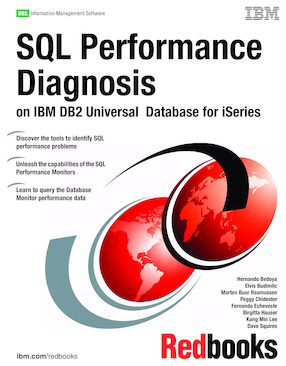SQL Performance Diagnosis on IBM DB2 Universal Database for iSeries
An IBM Redbooks publication
Note: This is publication is now archived. For reference only.

Published on 26 May 2006
ISBN-10: 0738497487
ISBN-13: 9780738497488
IBM Form #: SG24-6654-00
Authors: Hernando Bedoya, Elvis Budimlic, Morten Buur Rasmussen, Peggy Chidester, Fernando Echeveste, Birgitta Hauser, Kang Min Lee and Dave Squires
The goal of database performance tuning is to minimize the response time of your queries. It is also to optimize your server's resources by minimizing network traffic, disk I/O, and CPU time.
This IBM Redbooks publication helps you to understand the basics of identifying and tuning the performance of Structured Query Language (SQL) statements using IBM DB2 Universal Database for iSeries. DB2 Universal Database for iSeries provides a comprehensive set of tools that help technical analysts tune SQL queries. The SQL Performance Monitors are part of the set of tools that IBM i5/OS provides for assisting in SQL performance analysis since Version 3 Release 6. These monitors help to analyze database performance problems after SQL requests are run.
This book also presents tips and techniques based on the SQL Performance Monitors and other tools, such as Visual Explain. You'll find this guidance helpful in gaining the most out of both DB2 Universal Database for iSeries and query optimizer when using SQL.
Part 1. Introduction to DB2 Universal Database and database performance tools
Chapter 1. Determining whether you have an SQL performance problem
Chapter 2. DB2 Universal Database for iSeries performance basics
Part 2. Gathering, analyzing, and querying database performance data
Chapter 3. Overview of tools to analyze database performance
Chapter 4. Gathering database SQL performance data
Chapter 5. Analyzing database performance data using iSeries Navigator
Chapter 6. Querying the performance data of the Database Monitor
Chapter 7. Using Collection Services data to identify jobs using system resources
Chapter 8. Analyzing database performance data with Visual Explain
Part 3. Additional tips
Chapter 9. Tips to prevent further database performance problems
Appendix A. Tools to check a performance problem